At Xiang La Hui, the cooking is as complex as it is spicy

- Share via
Mao xue wang — a spicy stew with origins in Chongqing, southwestern China’s megacity — always contains a patchwork of ingredients emphasizing varied textures. Xiang La Hui, a new Sichuan restaurant in Alhambra, serves an extravagant version.
Assorted cuts of meat loll in a crimson stock raging with chile-infused oil. Dip the ladle beneath garnishes of scallion, snipped red chiles and electric Sichuan peppercorns and the emerging forms grow distinct: ribbons of pork, beef, peeled shrimp, feathery tripe and slices of Spam (a common modern addition). Xue means “blood,” and cubes of jellied duck’s blood also bob in the mix. Its smoothness resembles silken tofu.
Circling back to the stew’s broth: It hums with piercing heat, but flavors of ginger and star anise chime through with intentional clarity. Sichuan is L.A.’s ascendant regional Chinese cuisine of the decade; food writers have made a slogan out of repeating that the area’s cooking is about more than fire-hosing the taste buds with punishing Scoville heat units.
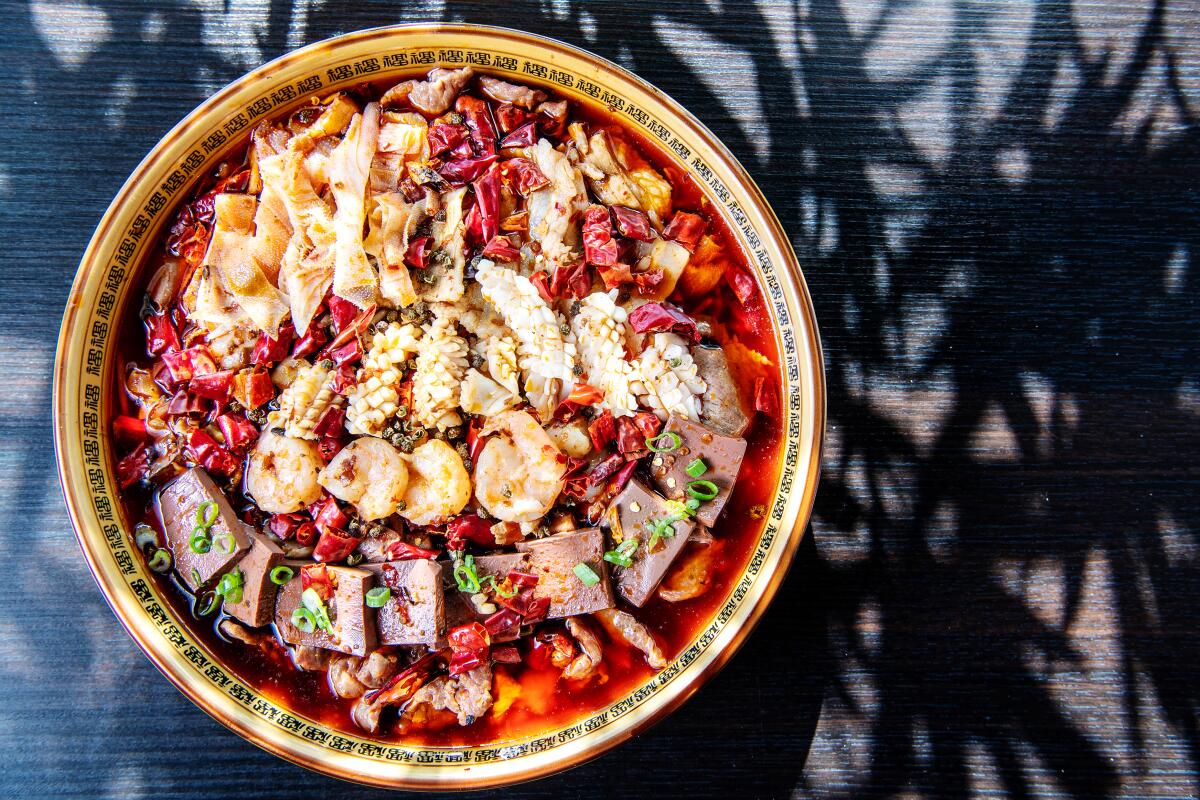
Xiang La Hui’s menu epitomizes the complexities, by design. Owner Will Wang and chef Ning Du are both natives of Chongqing, which became its own municipality in 1997 but shares culinary traditions with the Sichuan province.
A glorious hot pot onslaught is in play, and Sichuan standard-setters like Chengdu Taste and Sichuan Impression run multiple locations; a new entrant needs an advantage to distinguish itself. Wang is highlighting some of the cuisine’s most nuanced dishes — spicy, yes, but also intricately spiced — and he’s banking on an audience savvy enough to appreciate a current of subtlety ripping underneath the burn. Sichuan cuisine’s repertoire is vast; smart interpretations are numberless. Xiang La Hui reminds us that there’s plenty of room still for more.
Staffers hand diners an elaborate menu of color-saturated food photos on glossy pages; most every dish shown is flushed some shade of burning red. A friend raised in China wondered aloud if the menu’s production value meant Xiang La Hui is part of a Chinese chain. Valid question, but Wang is a solo operator. The booklet’s coffee-table quality reflects his overall contemporary design aesthetic. Dark wood paneling frames the 70-seat room. Light fixtures bring to mind gilded birdcages. Rainbow rows of beer and soda bottles glow on backlighted shelves behind the bar.

The menu visuals do their work: a centerfold spread of kung fu boiled beef served in a gleaming copper pot compels me to try it. The name is a tweak to a Sichuan classic with the deceptive title of “water-cooked beef.” First the kerchiefs of sliced beef simmer briefly in broth; the pot arrives at the table and a server pours boiling oil over top from a silver teapot. The sizzling oil dances over the dish like a downpour across a pond; the smell of scorched chiles blooms in the air. Sichuan devotees will want to compare this take to the one served at Chengdu Taste. I favor the one here for its head-clearing surge of aromatics.
Serrano pepper beef brings even more of a fragrant wallop. The meat steeps in a mildly fiery liquid swirling with spice: cinnamon, bay leaf, cumin, black cardamom. Du was known for his skill with this dish when he cooked at a nearby outpost of the Meizhou Dongpo chain, and it is masterful. It’s easy enough to sidestep the scattering of hot green peppers, but it’s worth experiencing the contrast between the tingle of the broth and the direct blast of fresh chile.
Sichuan meals tend to start with a few smaller cold items — to kei wei, or “open the stomach,” as Fuchsia Dunlop notes in her magnum opus, “The Food of Sichuan.” Look for bright, crisp options: sliced lotus root, lightly vinegary enoki mushrooms, squiggles of fried pig’s ear in chile oil, garlicky (arguably too garlicky) cucumbers. Most Sichuan restaurants have their own variation on liang ban ji, or cold-dressed chicken; Wang’s shines a fierce scarlet, but the heat comes off relatively restrained.

I’d more eagerly jump into the fire with la zi ji, the Chongqing-style nuggets of boneless chicken marinated in over three dozen spices and fried before landing in a confetti of dried red chiles. This is a Sichuan restaurant standby done exceptionally well. Each bite radiates a tingling aura — a sensation so visceral that I envision it literally spreading out like an expanding halo across the taste buds.
Cumin-scented toothpick lamb creates a similar effect. Chengdu Taste popularized the dish in Southern California when it opened in 2013. Dunlop remarks in her book that Sichuan has long been an ever-evolving culinary melting pot; toothpick lamb is a spinoff of the lamb-cumin combination favored by the Hui Muslim population that migrated from the north to Chengdu, Sichuan’s capital. This one nails the details: The meat’s crisp edges give way to tenderness; the spices register as dusky but not gritty. A straight-up entree of cumin lamb leans oilier; the toothpicks hold sway.

A meal can be ordered as a progression in capsicum levels. Starting tame? There’s another lamb dish, of roasted ribs and other cuts, splayed over foil on a wooden platter built to resemble an arching bridge. The meat is beautifully rendered, with a dry, earthy cumin-laced spice mix for dipping.
Xiang La Hui’s balanced, saucy mapo tofu accelerates the heart rate but doesn’t cause a sweat.
Mao xue wang whams with full ma la; your lips tingle, your palate is numbing and your brain starts sending SOS signals. Stir-fried diced rabbit delivers double shock treatments from seed-riddled green peppers and smoky red chiles.
Tilapia with pickled vegetable soup, a riff on a dish called suan cai yu, throws chiles-plus-acid thunderbolts; it thrills and also nicely swerves from the undercurrent of sweet spices in other dishes. As part of the local lexicon, its astringent bite winningly contrasts with the fish with green (or rattan) peppers beloved at Chengdu Taste and Sichuan Impression.
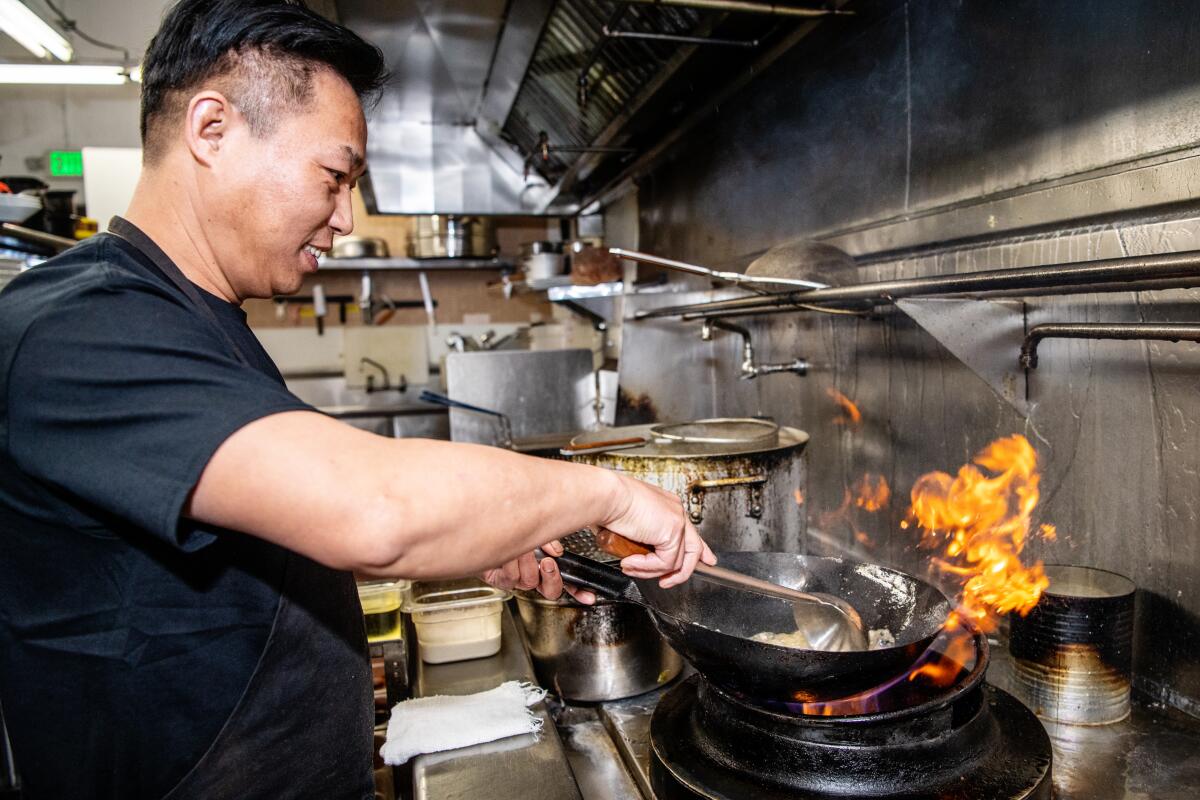
Perhaps it was a wild anomaly one night, but among Xiang La Hui’s many examples of balance, the only truly nuclear-thermal blast came from cold noodles with shredded chicken. The menu listed its heat index as one out of three chiles, but the ruddy oil poured over top, rife with Sichuan peppercorns, left me feeling like a car battery on the receiving end of jumper cables. Would I order it again? Maybe.
Xiang La Hui
Location: 621 W. Main St., Alhambra, (626) 703-4165, xiang-la-hui.business.site
Prices: small starter dishes $1.99-$3.99, larger cold appetizers $7.99-$14.99, most entrees $13.99-$27.99
Details: Visa and Mastercard accepted. Beer. Street parking. Wheelchair accessible.
Recommended dishes: mao xue wang (spicy mixed stew), toothpick lamb, Chongqing-style fried chicken, tilapia with pickled vegetable soup
Los Angeles Times Food Videos

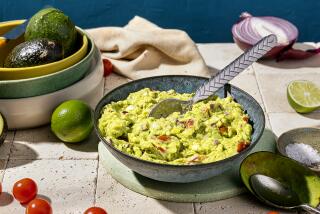
How to make this extra limey guacamole
6:55

The best Black-owned coffee shops to visit in Los Angeles
5:38
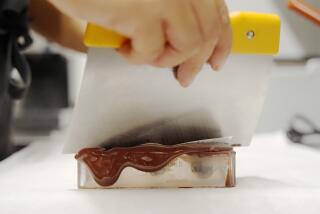
Making no-waste chocolate at this L.A. Michelin-star restaurant
5:12
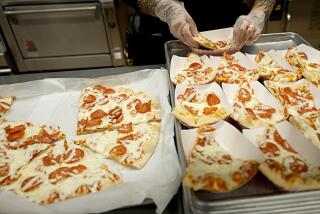
How L.A. schools feed up to 300,000 meals a day
6:52
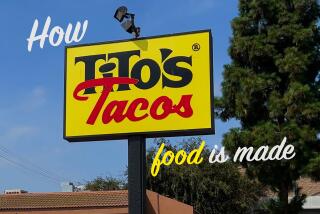
How Tito's Tacos food is made
9:52

Testing gas and induction stoves to see which is better
9:12
More to Read
Eat your way across L.A.
Get our weekly Tasting Notes newsletter for reviews, news and more.
You may occasionally receive promotional content from the Los Angeles Times.











